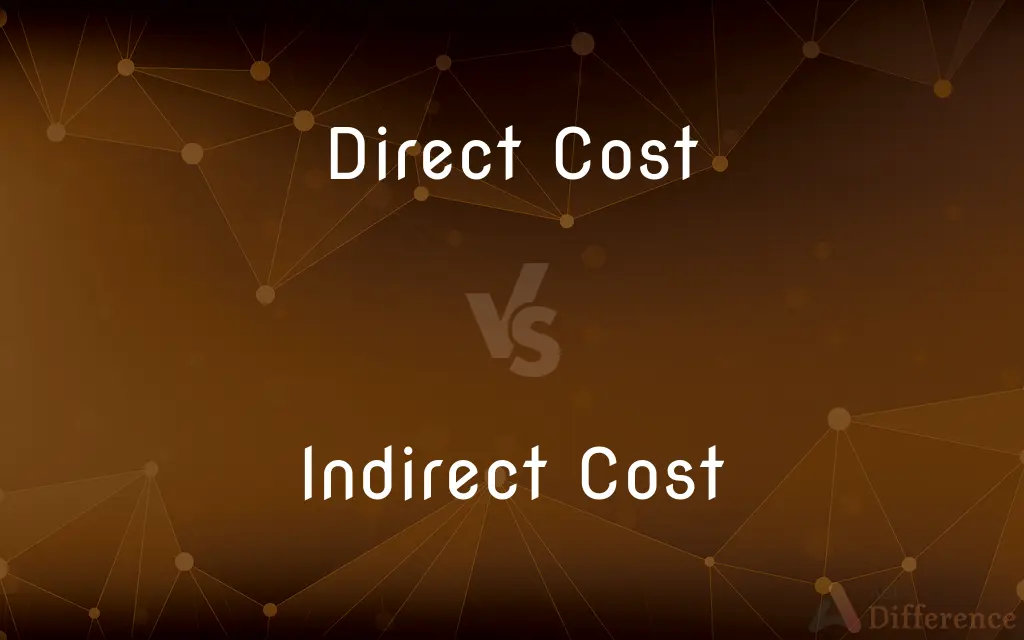Direct Cost vs. Indirect Cost — What's the Difference?
By Tayyaba Rehman — Published on October 6, 2023
Direct Cost is directly attributable to a specific project or product, while Indirect Cost is not directly linked and is distributed across multiple projects or products.

Difference Between Direct Cost and Indirect Cost
Table of Contents
ADVERTISEMENT
Key Differences
When businesses assess their expenses, Direct Cost and Indirect Cost are two essential categories. Direct Cost refers to expenses that can be traced directly to a specific product, service, or project. For example, the cost of materials and labor directly involved in producing a product is a Direct Cost. Conversely, Indirect Cost is not directly tied to any specific product, service, or project.
Direct Cost provides a clear, straightforward assessment of the expenses related to a particular output. For instance, in manufacturing, the cost of raw materials and the wages of workers on an assembly line are Direct Costs. On the other hand, Indirect Cost encompasses expenses like utilities, rent, or administrative salaries, which support the overall business operation but can't be allocated precisely to a single product or service.
Moreover, while Direct Cost can be variable, changing based on the quantity produced, Indirect Cost often remains fixed over a period, irrespective of the production volume. It is also worth noting that while Direct Cost can be easily measured and attributed, Indirect Cost requires allocation methods to distribute them across various products or services.
To sum up, understanding both Direct Cost and Indirect Cost is crucial for businesses. Direct Cost provides insights into the immediate costs of production, while Indirect Cost helps assess the broader expenses necessary for overall operations.
Comparison Chart
Attribution
Specific to a product or project
Distributed across multiple products or services
ADVERTISEMENT
Examples
Raw materials, direct labor
Rent, utilities, administrative salaries
Variability
Often variable based on production
Usually fixed over a period
Measurement
Easily measurable and traced
Requires allocation methods
Impact on Pricing
Directly influences product price
Distributed, impacting overall operational costs
Compare with Definitions
Direct Cost
Expenditure directly affecting product pricing.
A spike in Direct Cost led to an increase in the retail price.
Indirect Cost
Broad operational costs supporting overall business.
Rent and utilities were part of the company's Indirect Cost.
Direct Cost
Charges attributed without allocation methods.
The Direct Cost of the meal included ingredients and chef's time.
Indirect Cost
Expenditures requiring allocation methods for distribution.
The Indirect Cost of electricity was spread across all factory products.
Direct Cost
Expenses directly traceable to a product or service.
The Direct Cost of making the shoes included leather and laces.
Indirect Cost
Charges not immediately tied to production volume.
Despite producing more units, the Indirect Cost remained steady.
Direct Cost
Costs that change based on production quantities.
As the company increased output, its Direct Cost rose proportionally.
Indirect Cost
Expenses spread across multiple products or projects.
The Indirect Cost of the concert included venue maintenance.
Direct Cost
Immediate costs tied to specific outputs.
The Direct Cost for the event included the performers' fees.
Indirect Cost
Costs not directly attributable to specific outputs.
Manager salaries were considered an Indirect Cost.
Common Curiosities
Why are utilities often considered an Indirect Cost?
Because they support the entire operation and aren't tied to a specific product.
What is a Direct Cost?
It's an expense directly attributable to a specific product or project.
Can labor be a Direct Cost?
Yes, if it's directly involved in production, like assembly line workers.
How does Indirect Cost differ from Direct Cost?
Indirect Cost supports overall operations and isn't directly tied to a specific output.
Why is understanding Indirect Cost crucial for pricing?
It ensures all operational costs are covered in product pricing.
Which cost is easier to trace, Direct Cost or Indirect Cost?
Direct Cost.
Is rent typically a Direct or Indirect Cost?
Indirect Cost, as it supports overall operations.
How can businesses allocate Indirect Costs?
Using allocation methods based on usage, square footage, or other metrics.
Do Direct Costs always vary with production?
Often, but not always. Some Direct Costs can be fixed.
Is office supplies a Direct Cost or Indirect Cost?
Typically, they are considered an Indirect Cost as they support general operations.
Can marketing be considered a Direct Cost?
It depends; if it's for a specific product, yes. Otherwise, it's often indirect.
Can a cost be both Direct and Indirect?
No, costs are categorized as either Direct or Indirect based on their nature.
Why might a business analyze its Indirect Costs?
To find efficiencies and manage overall operational expenses.
How do Direct Costs impact profit margins?
They directly influence the cost of producing goods, affecting profitability.
How do manufacturers manage rising Direct Costs?
They might adjust pricing, find cheaper materials, or improve efficiencies.
Share Your Discovery

Previous Comparison
Velocity vs. Acceleration
Next Comparison
Almond Milk vs. Coconut MilkAuthor Spotlight
Written by
Tayyaba RehmanTayyaba Rehman is a distinguished writer, currently serving as a primary contributor to askdifference.com. As a researcher in semantics and etymology, Tayyaba's passion for the complexity of languages and their distinctions has found a perfect home on the platform. Tayyaba delves into the intricacies of language, distinguishing between commonly confused words and phrases, thereby providing clarity for readers worldwide.
















































